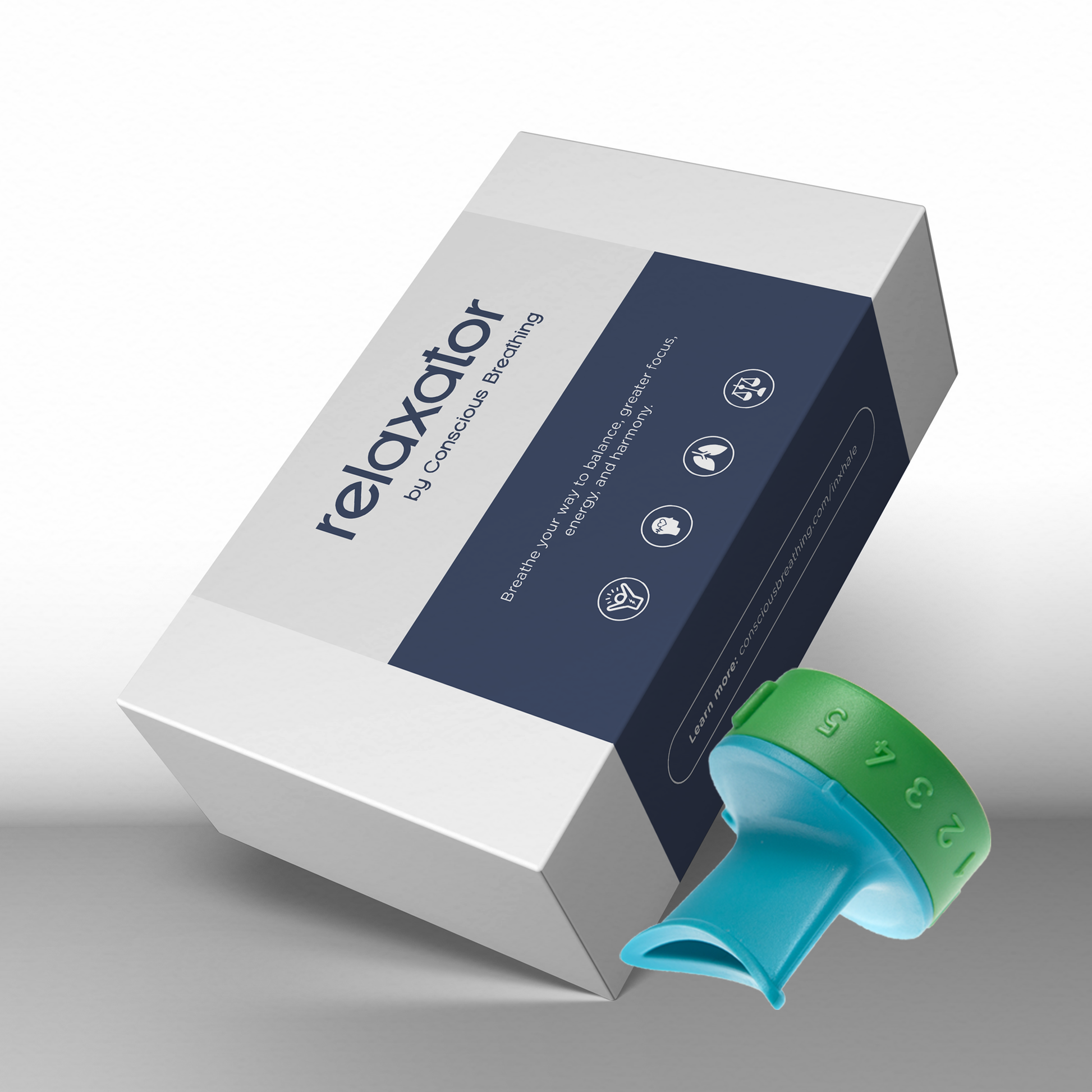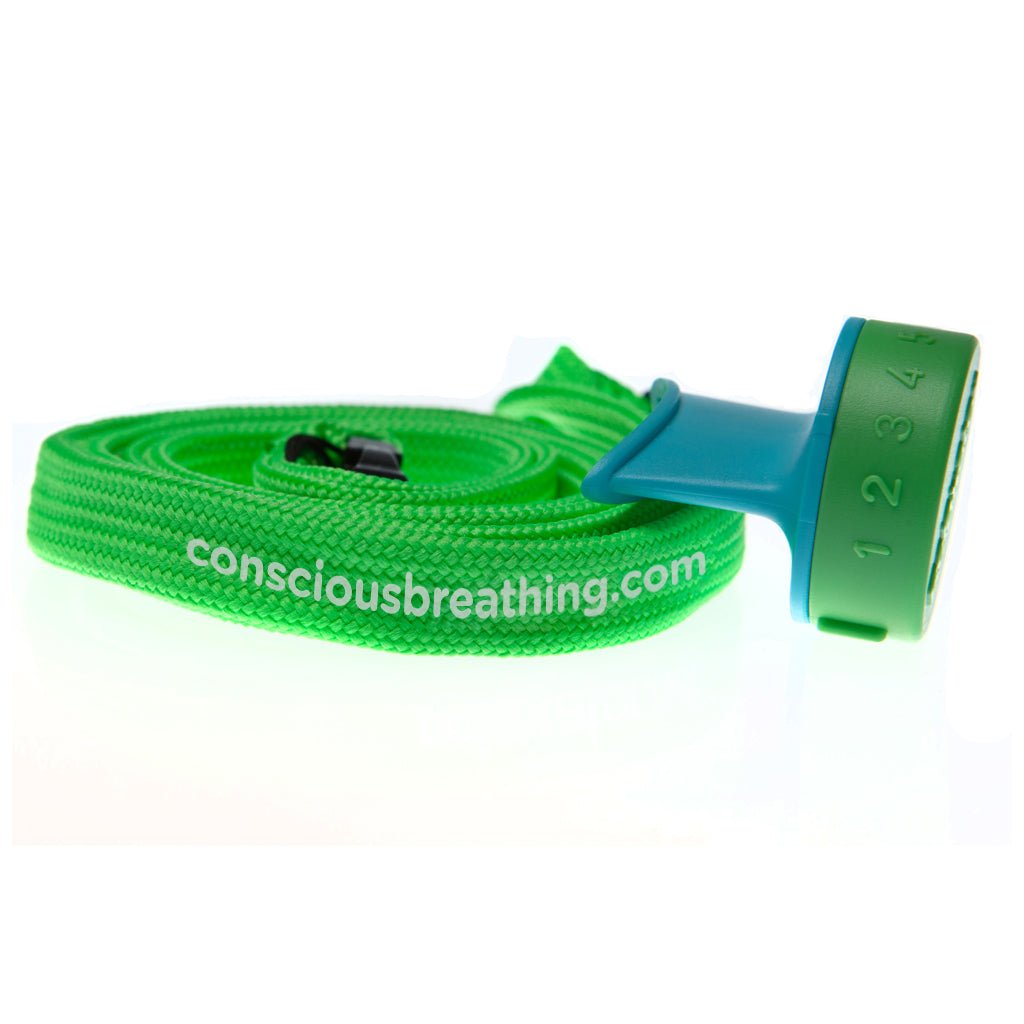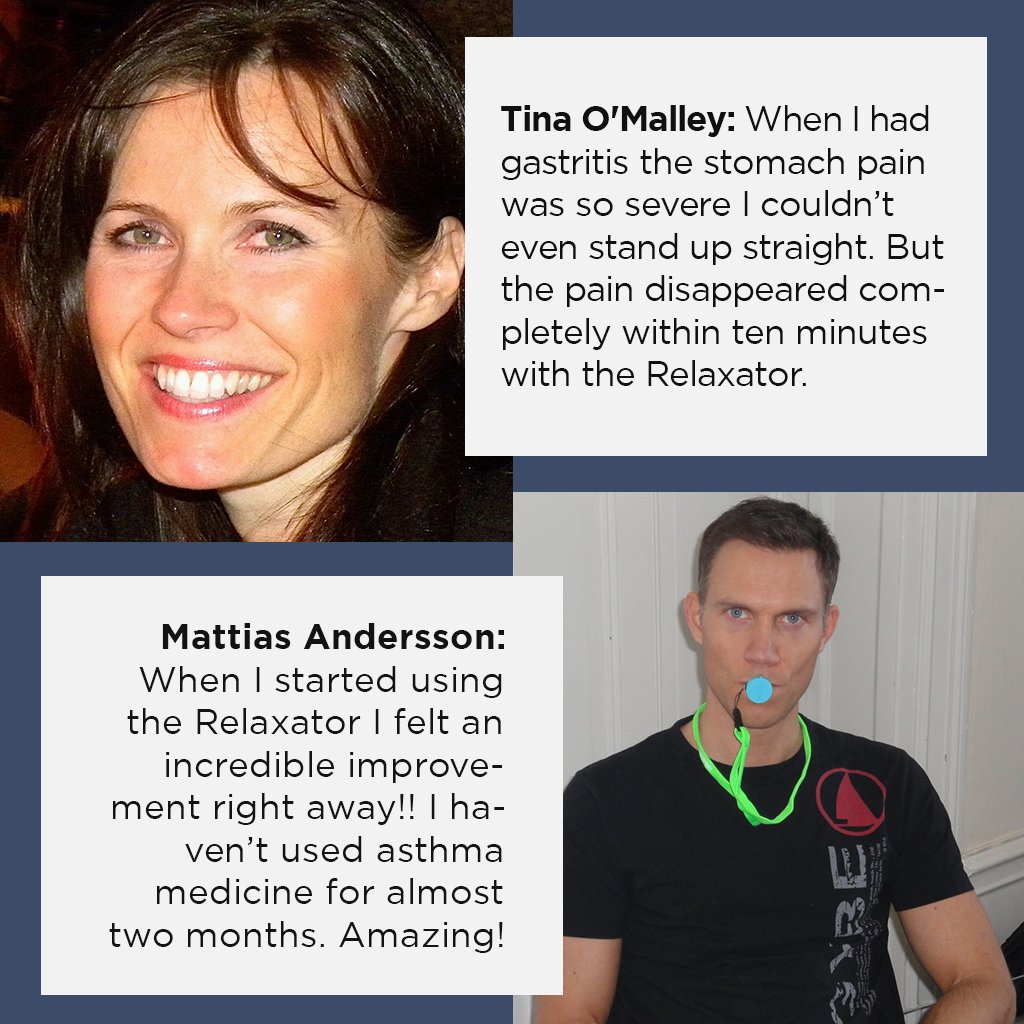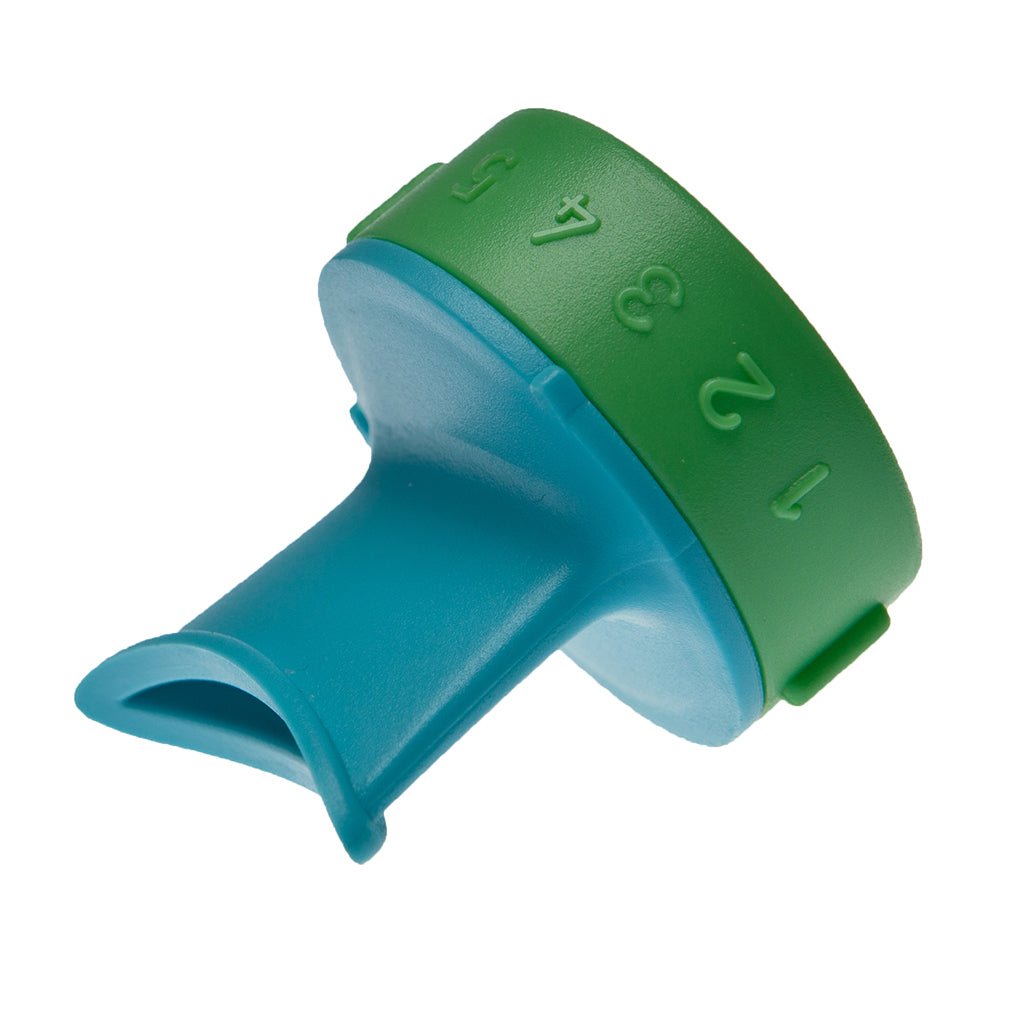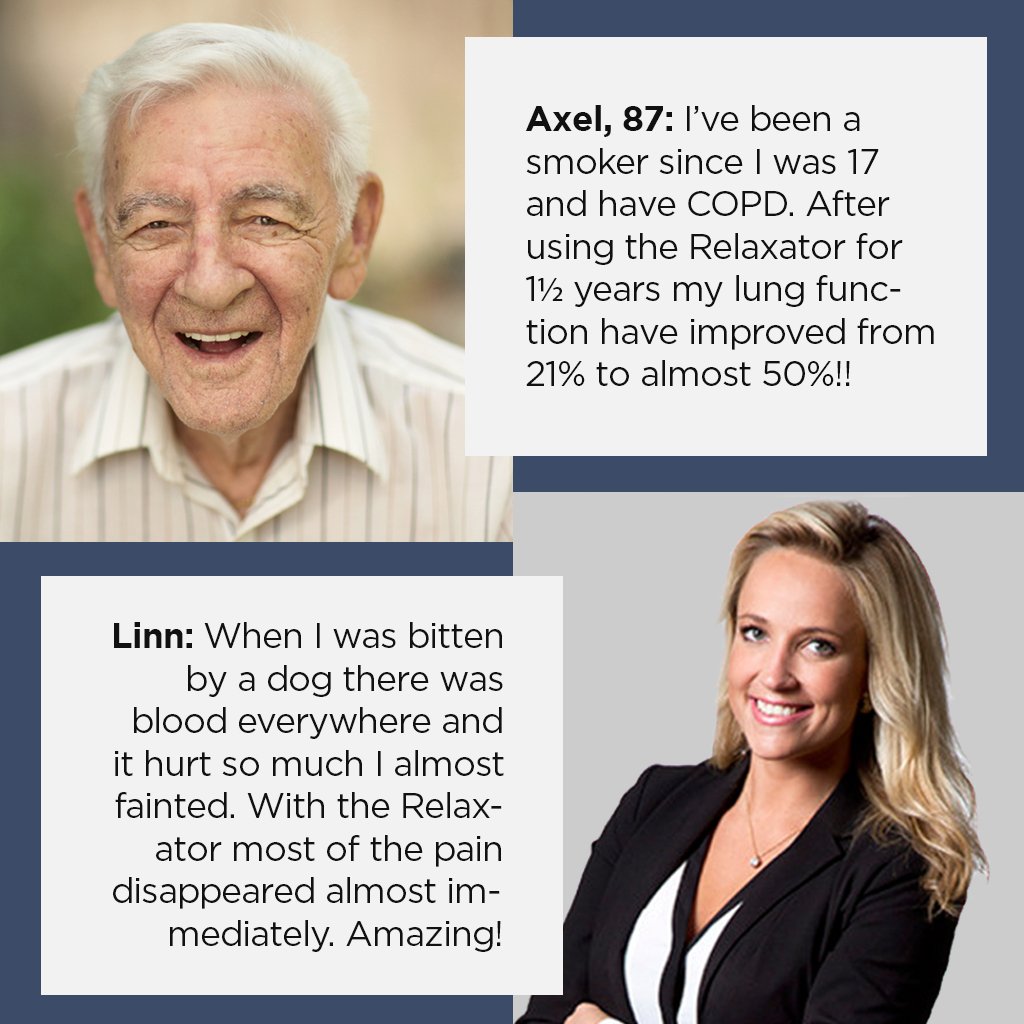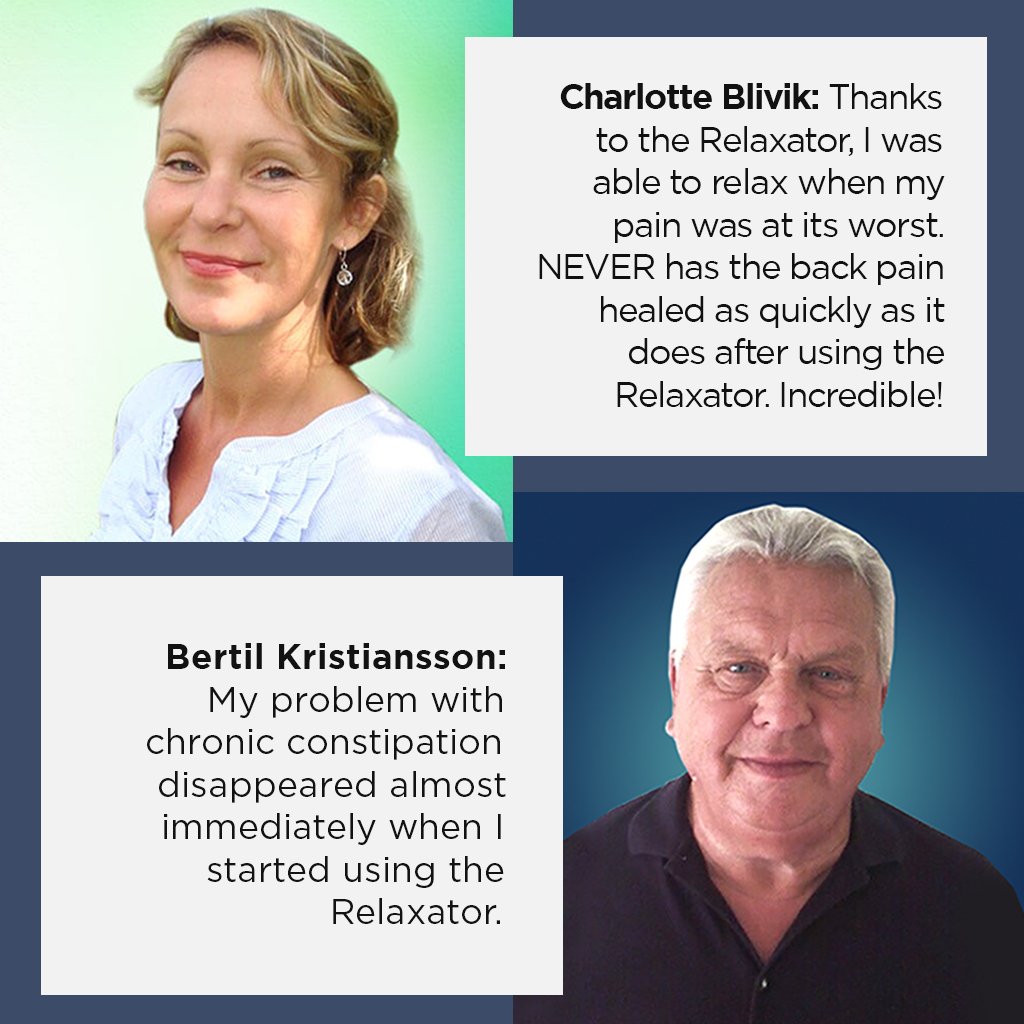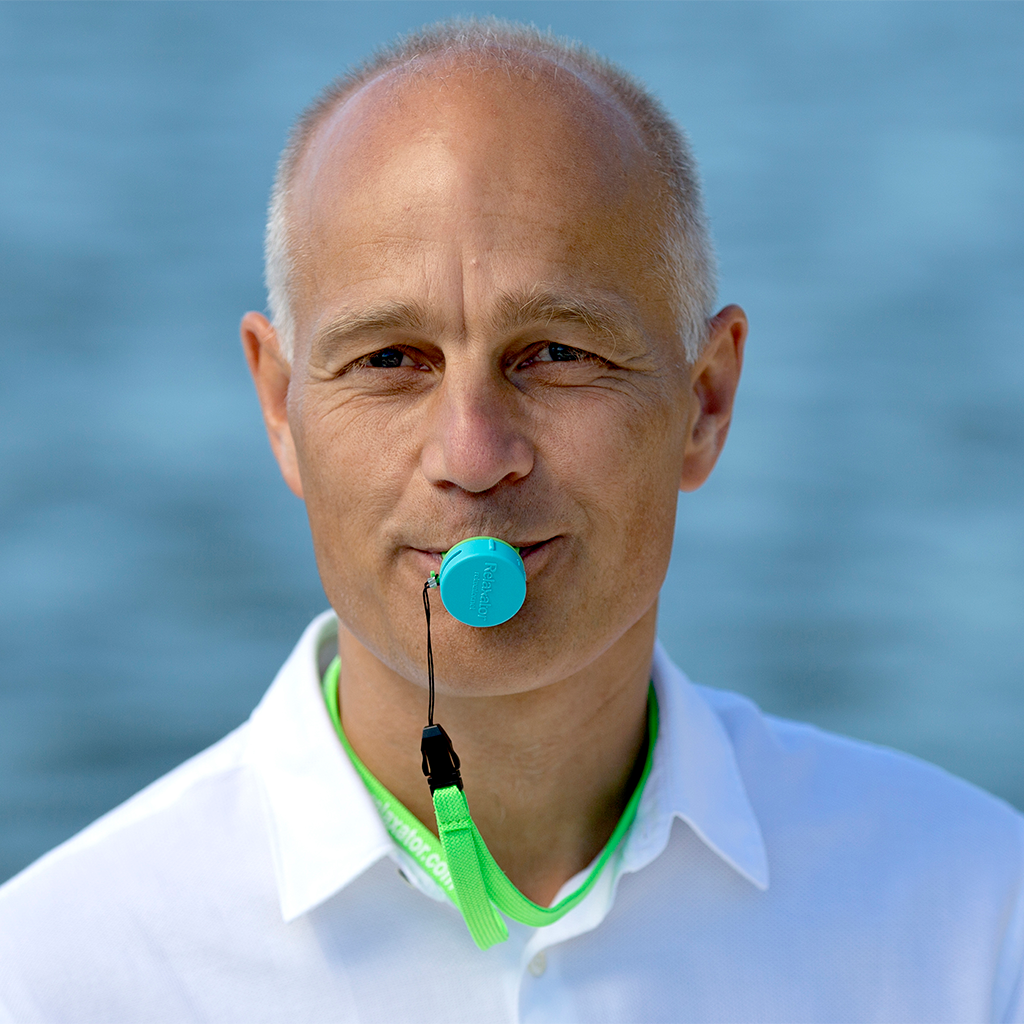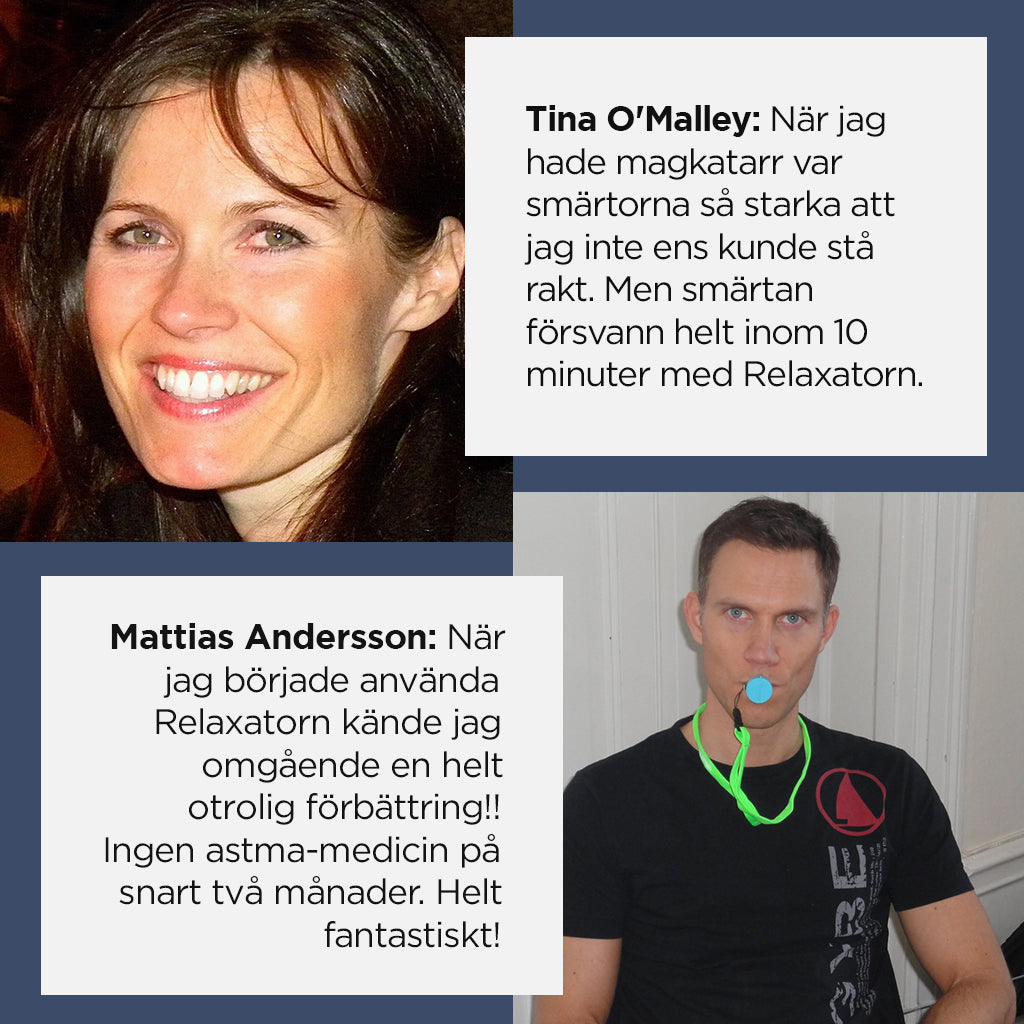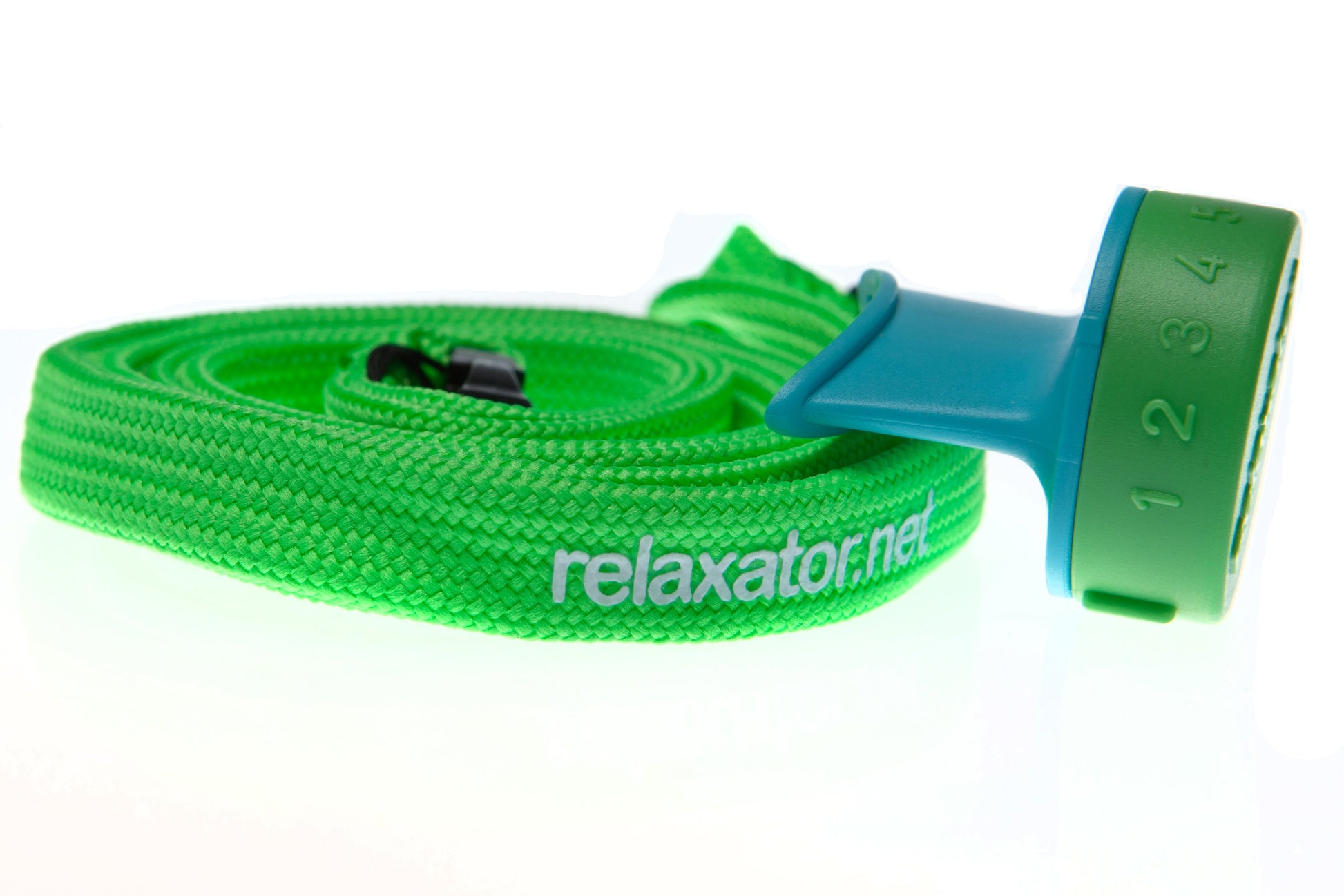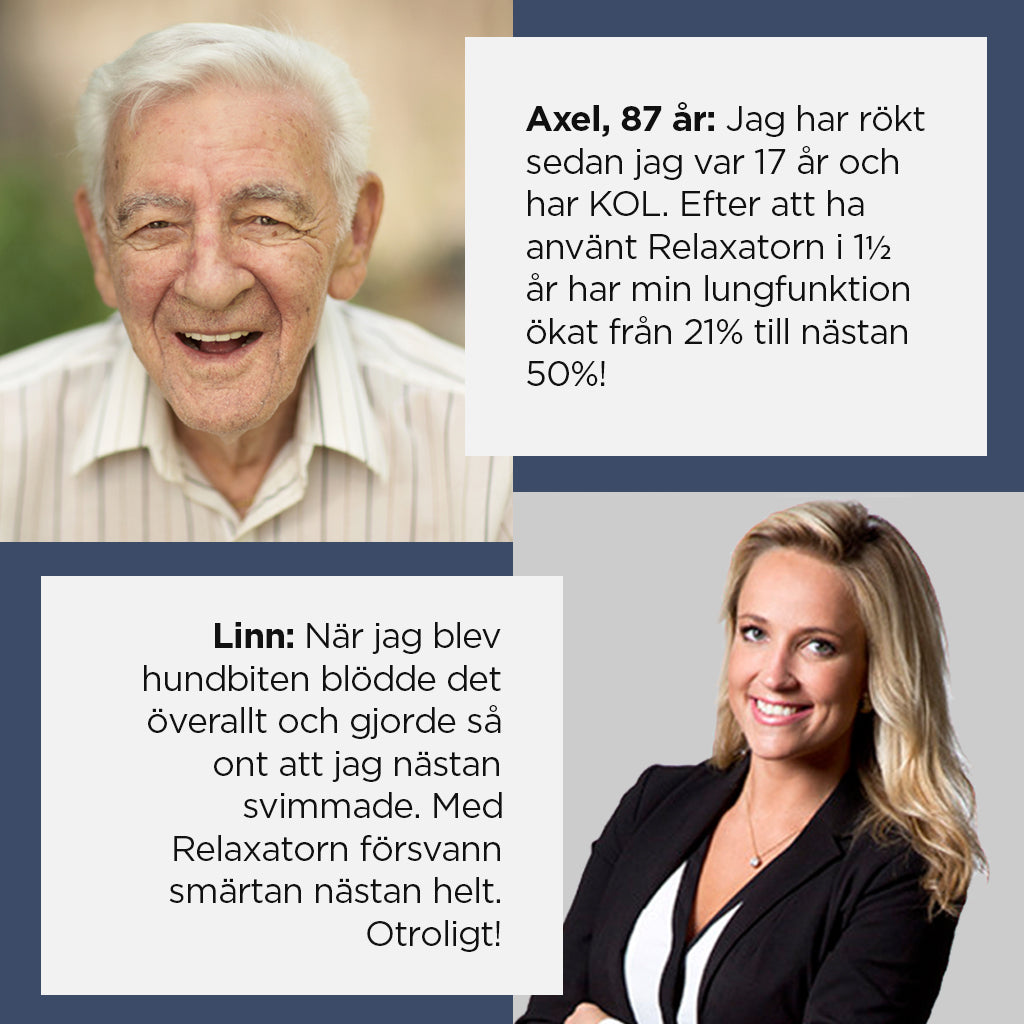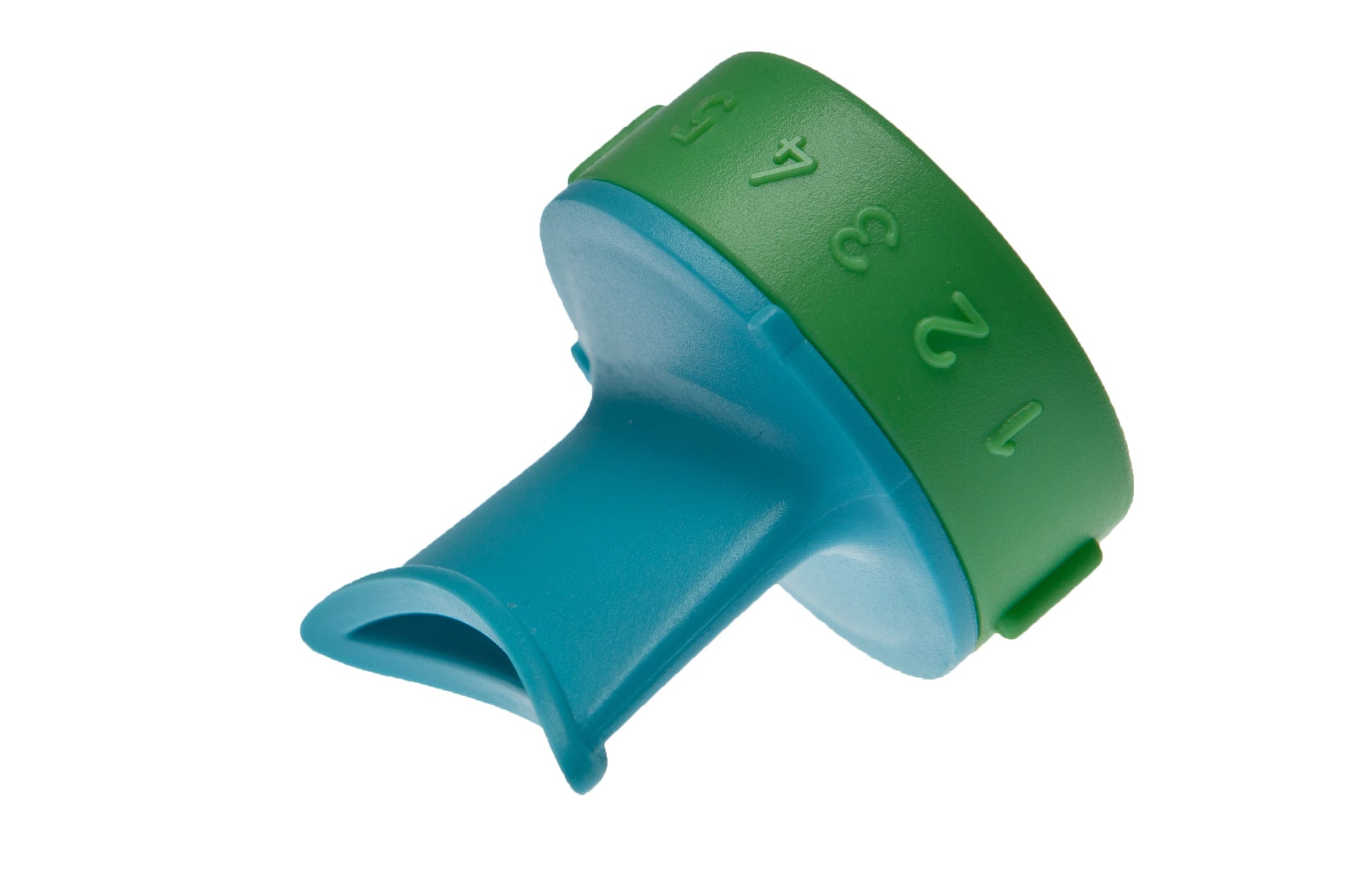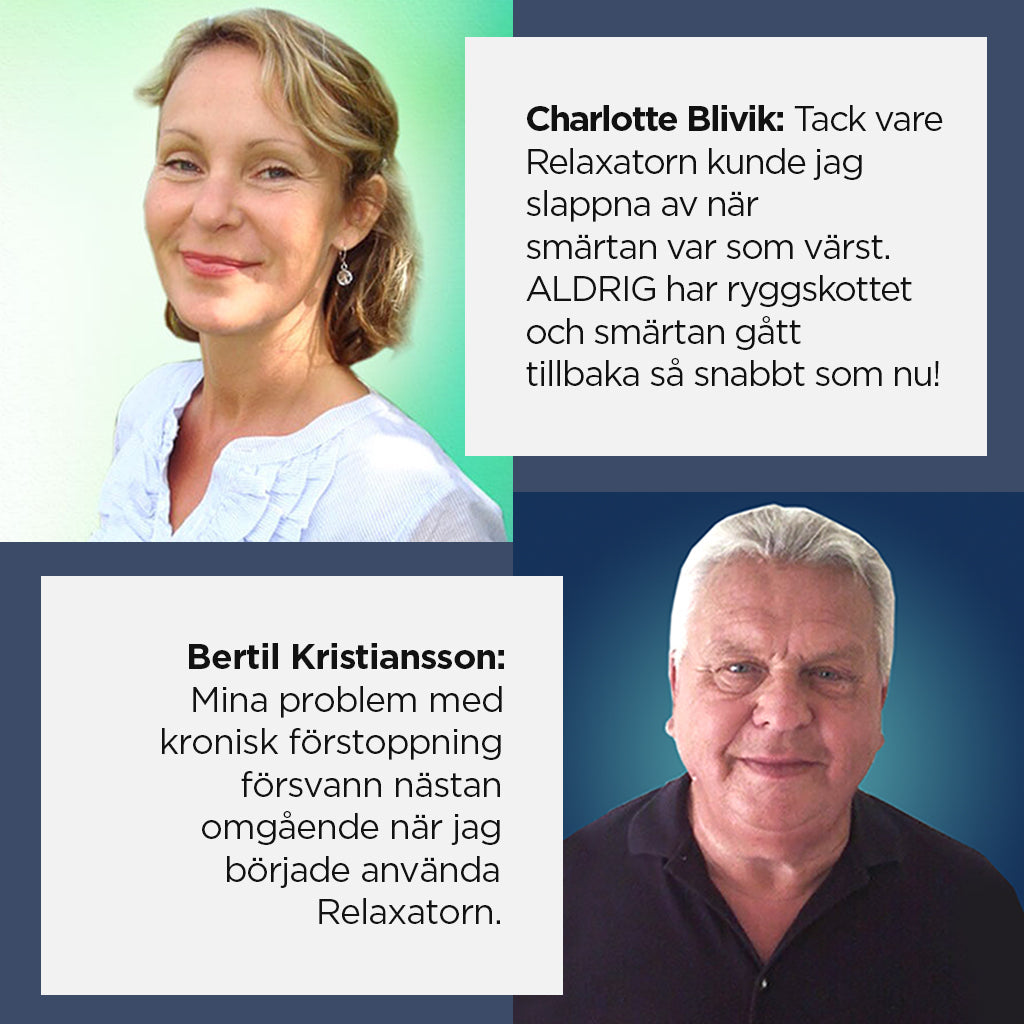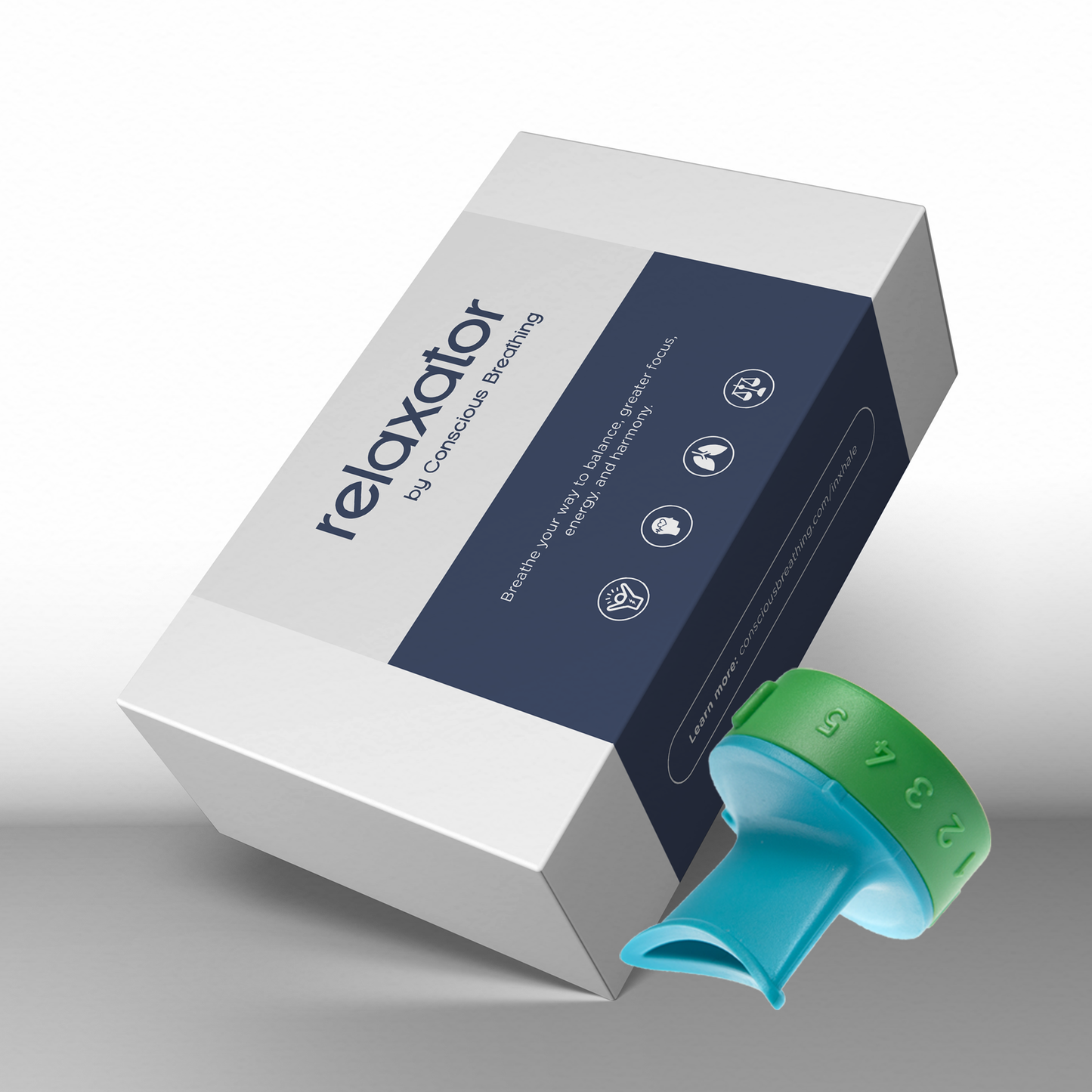
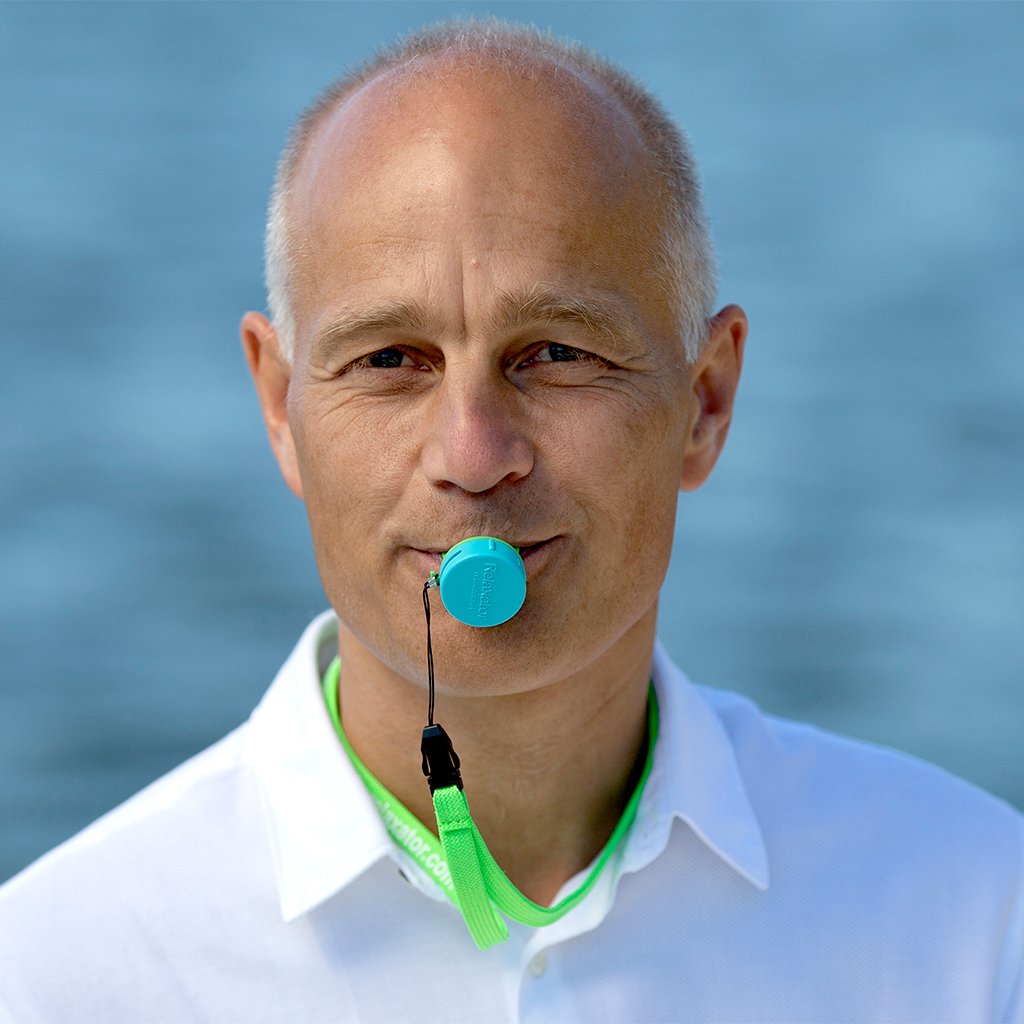

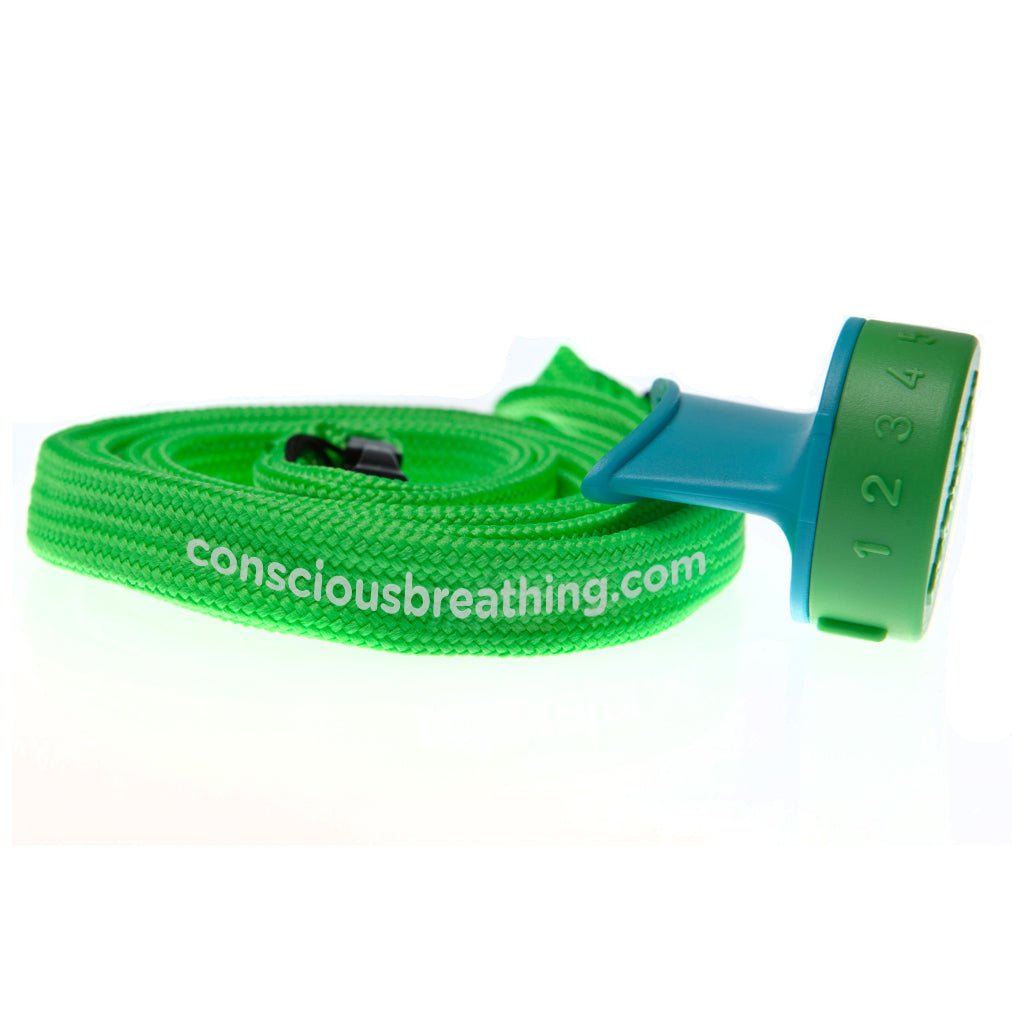
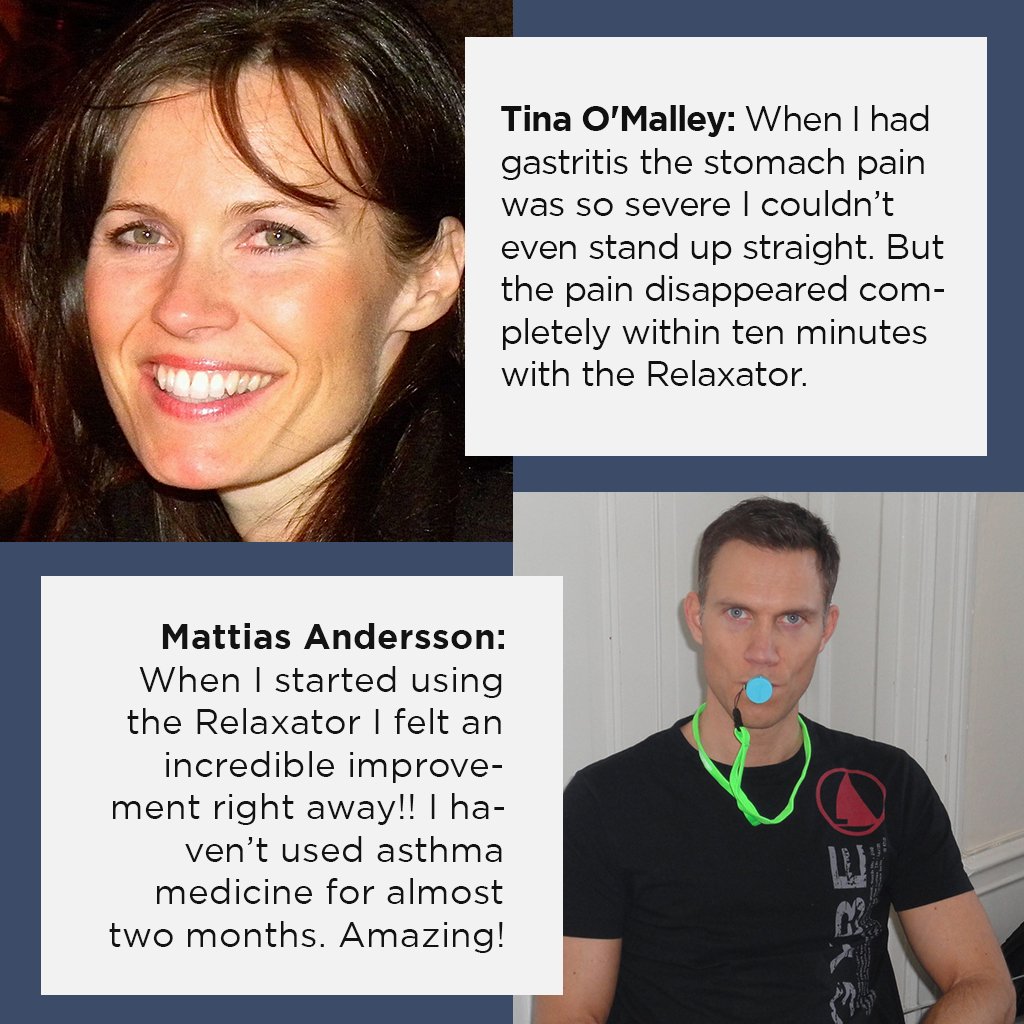
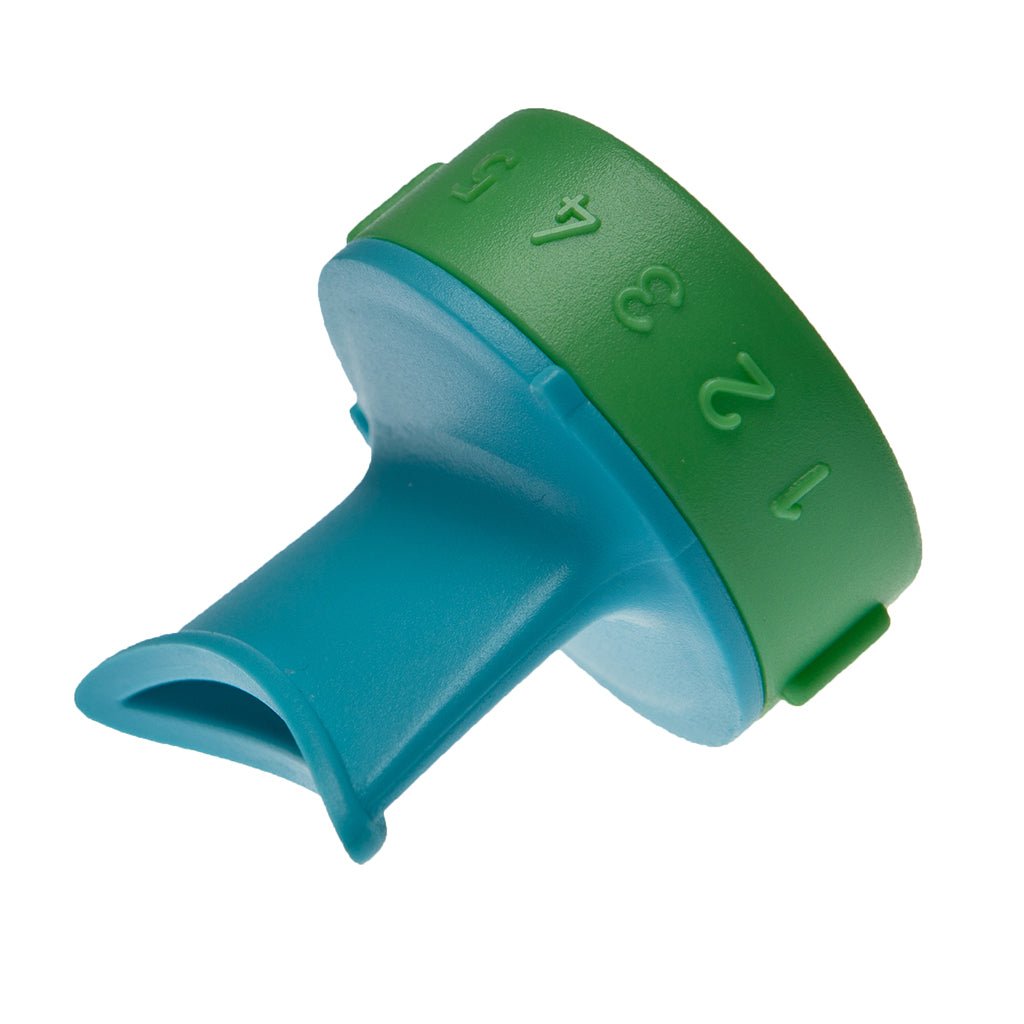
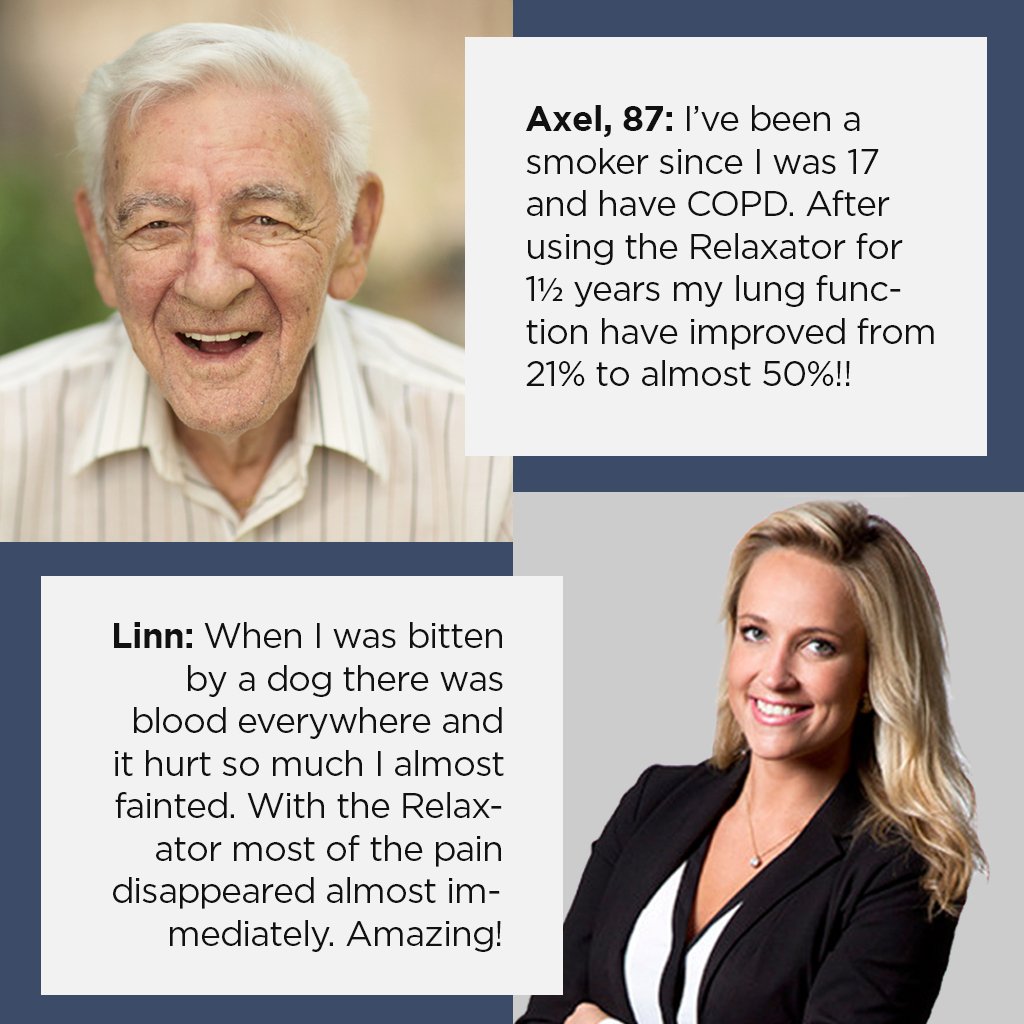
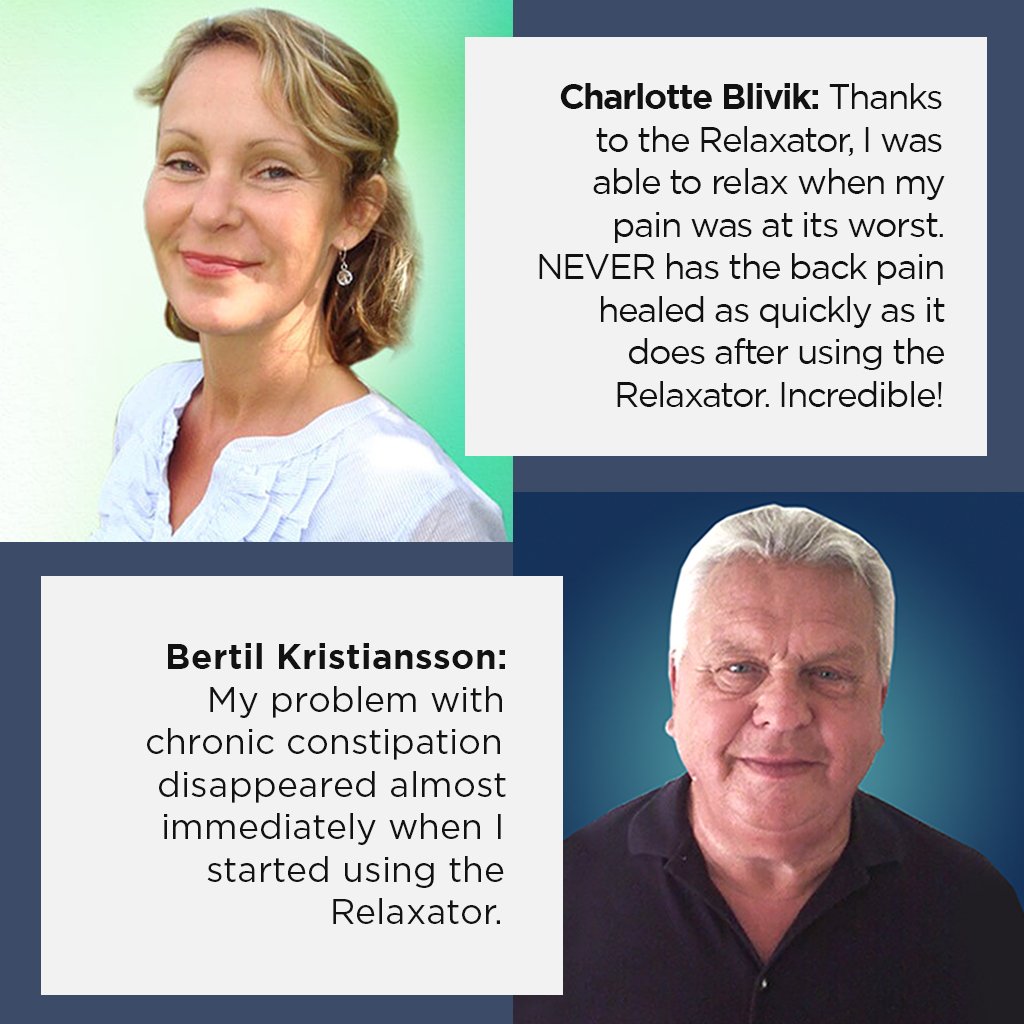
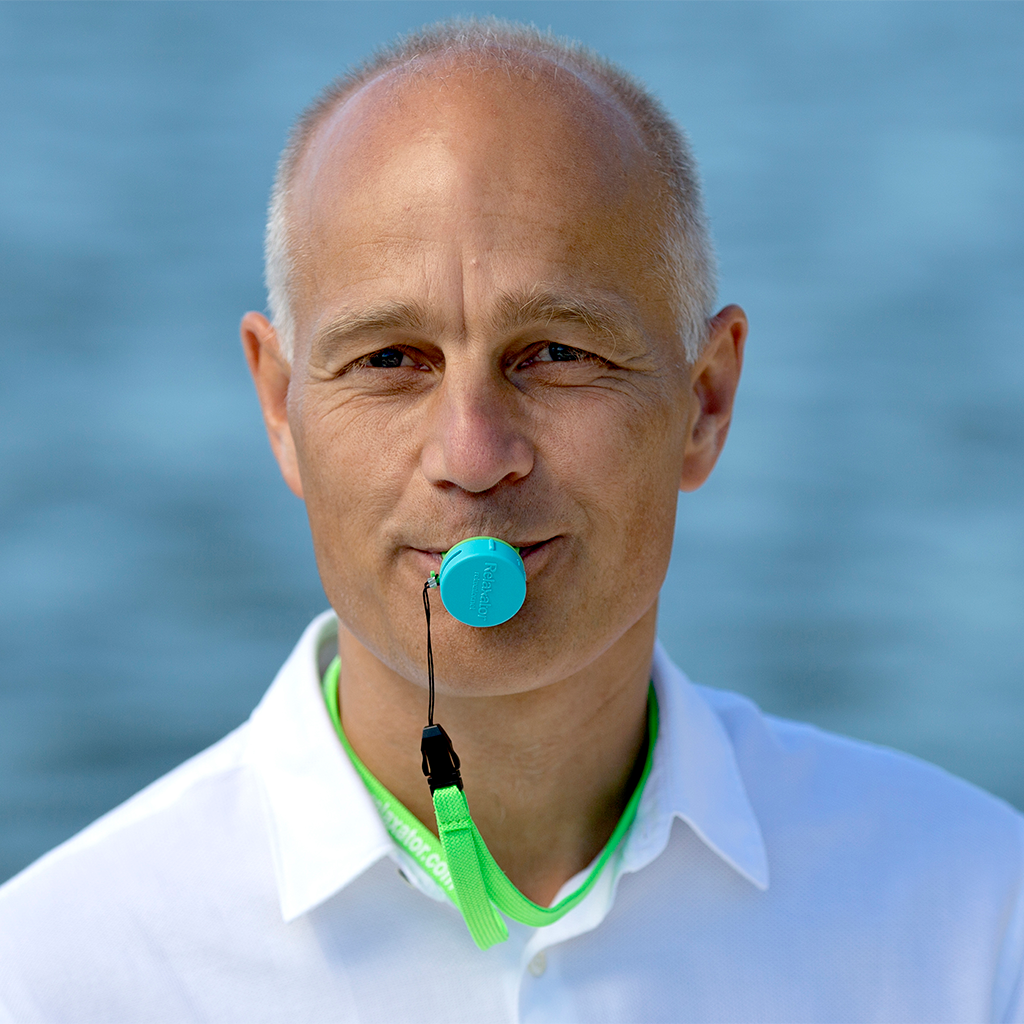

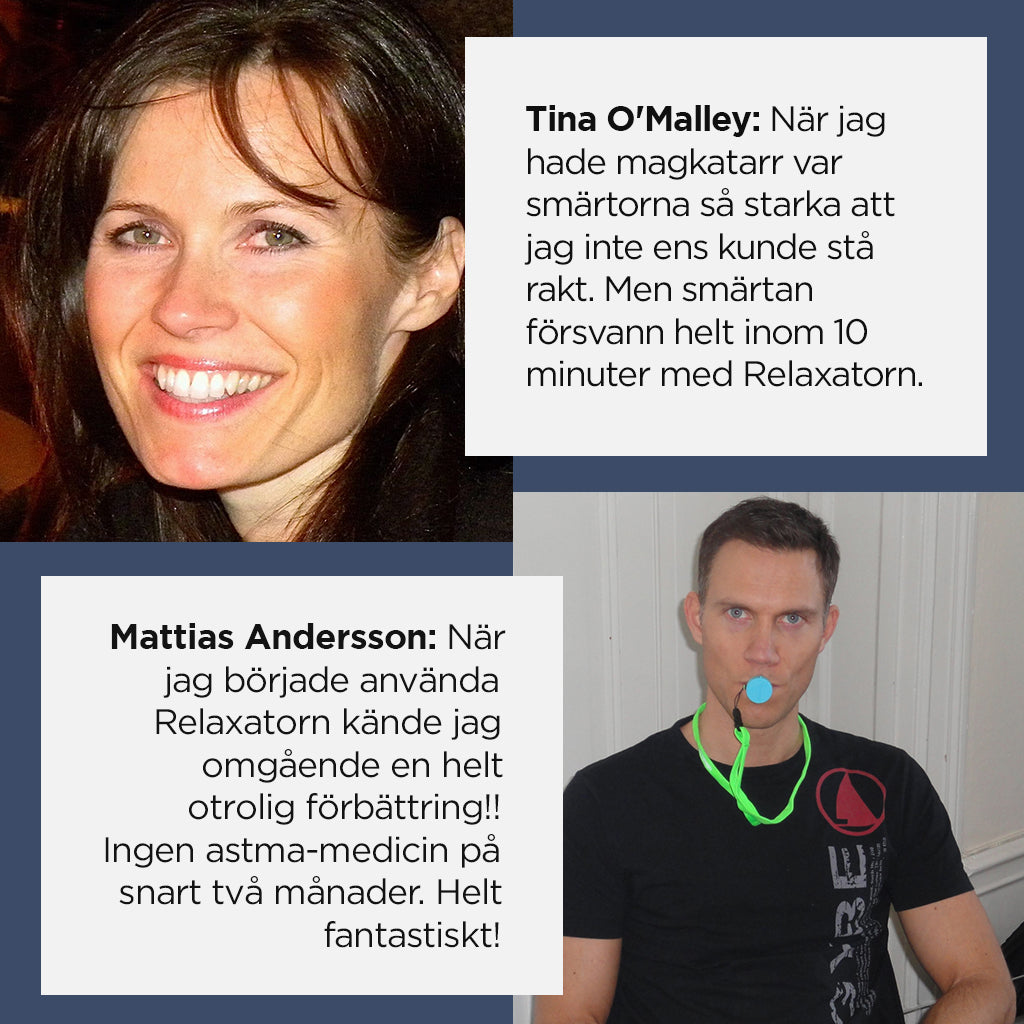
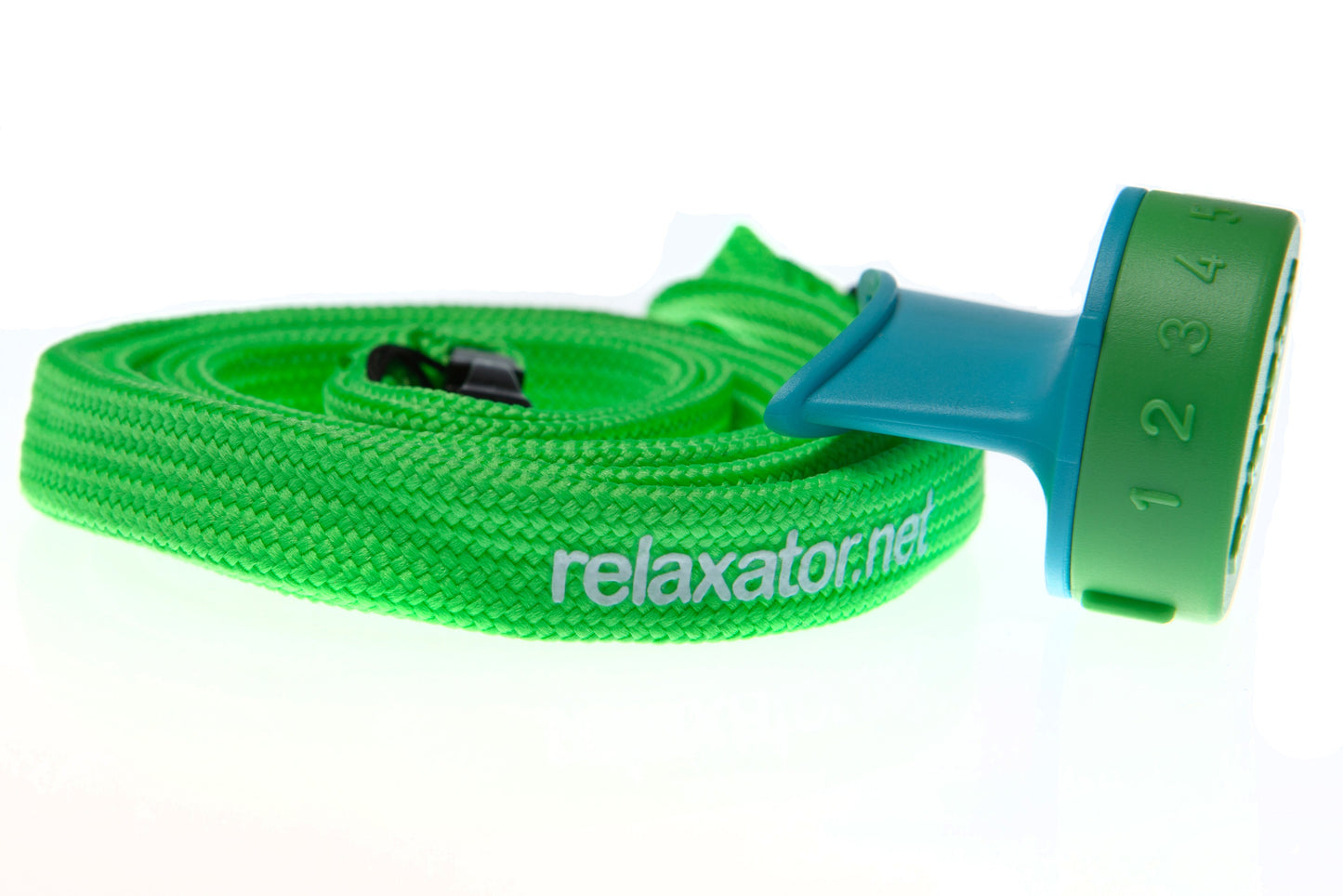
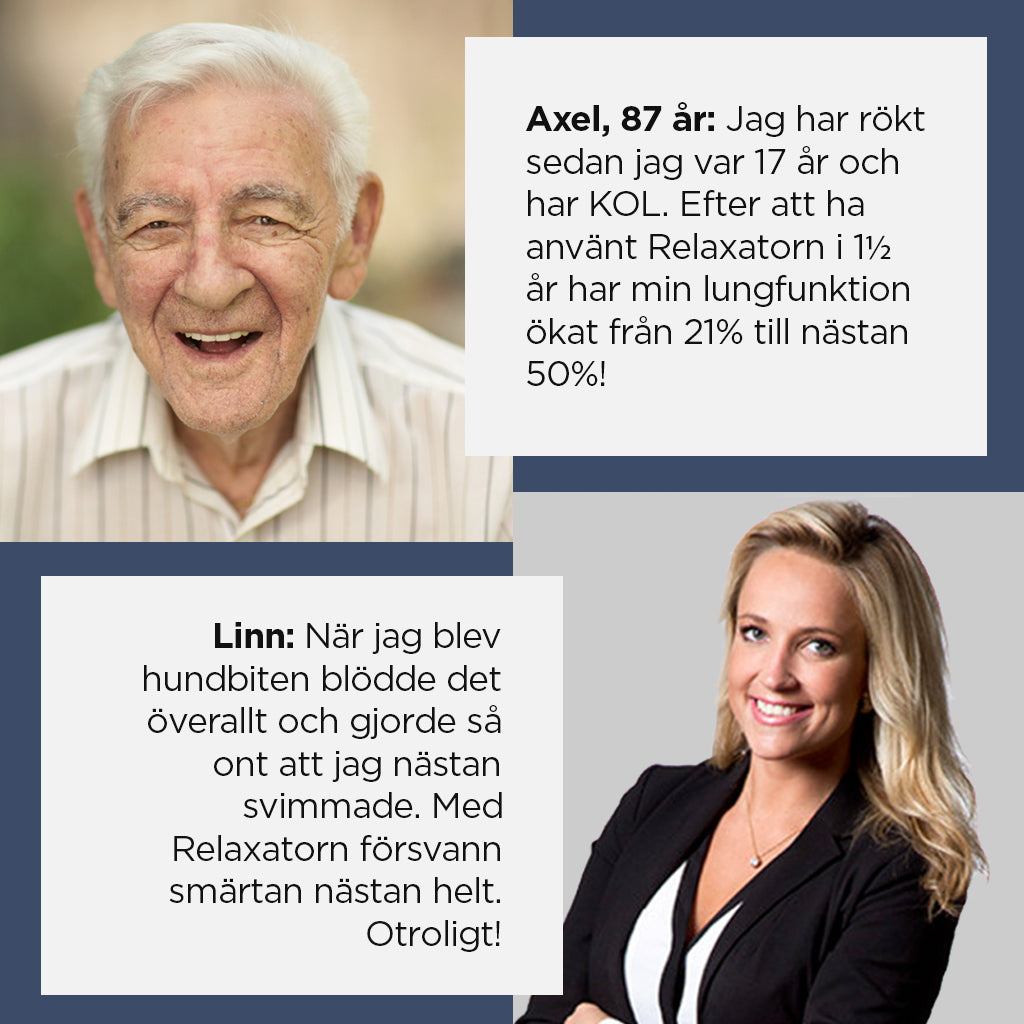
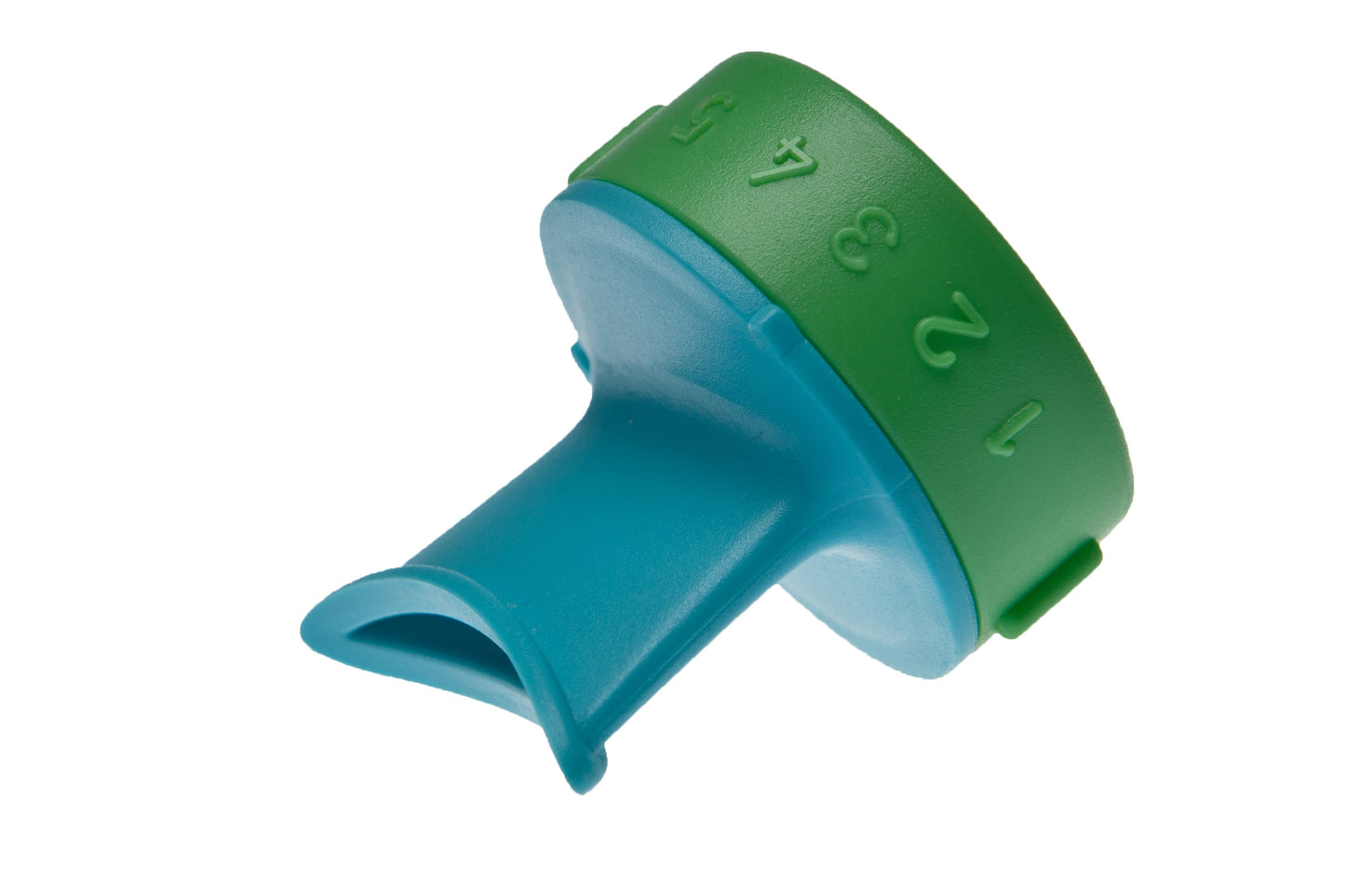
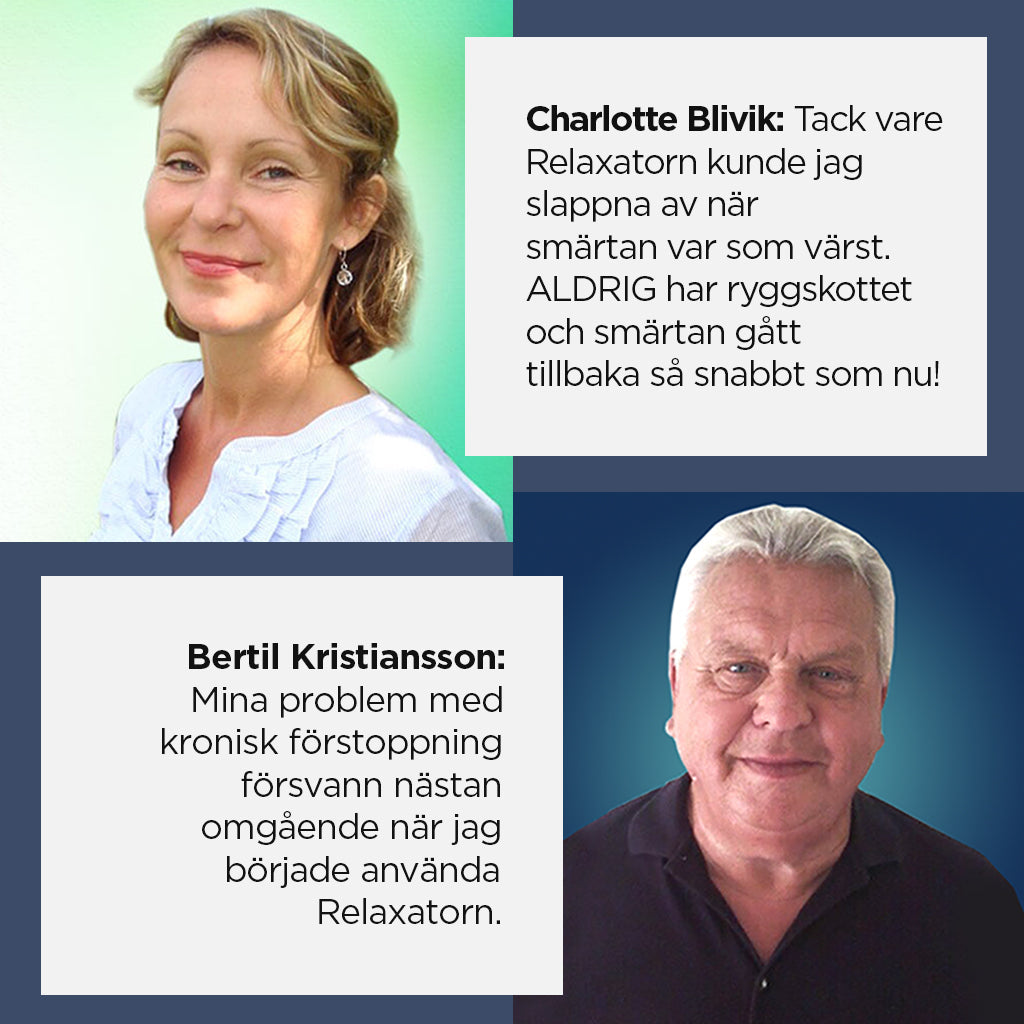
THE RELAXATOR
Go from feeling stressed-out and overwhelmed to experience an inner calm, energy and focus - one breath at a time.

SLOW BREATHING - CALMER BRAIN
Stress, pressure and a racing mind is a big problem for many people. With the Relaxator you prolong the exhalation, which causes your brain to relax.
Exhalation is connected to relaxation. Increased relaxation means you experience less stress and more harmony. When your body is more relaxed, you function better and can accomplish more with less effort.
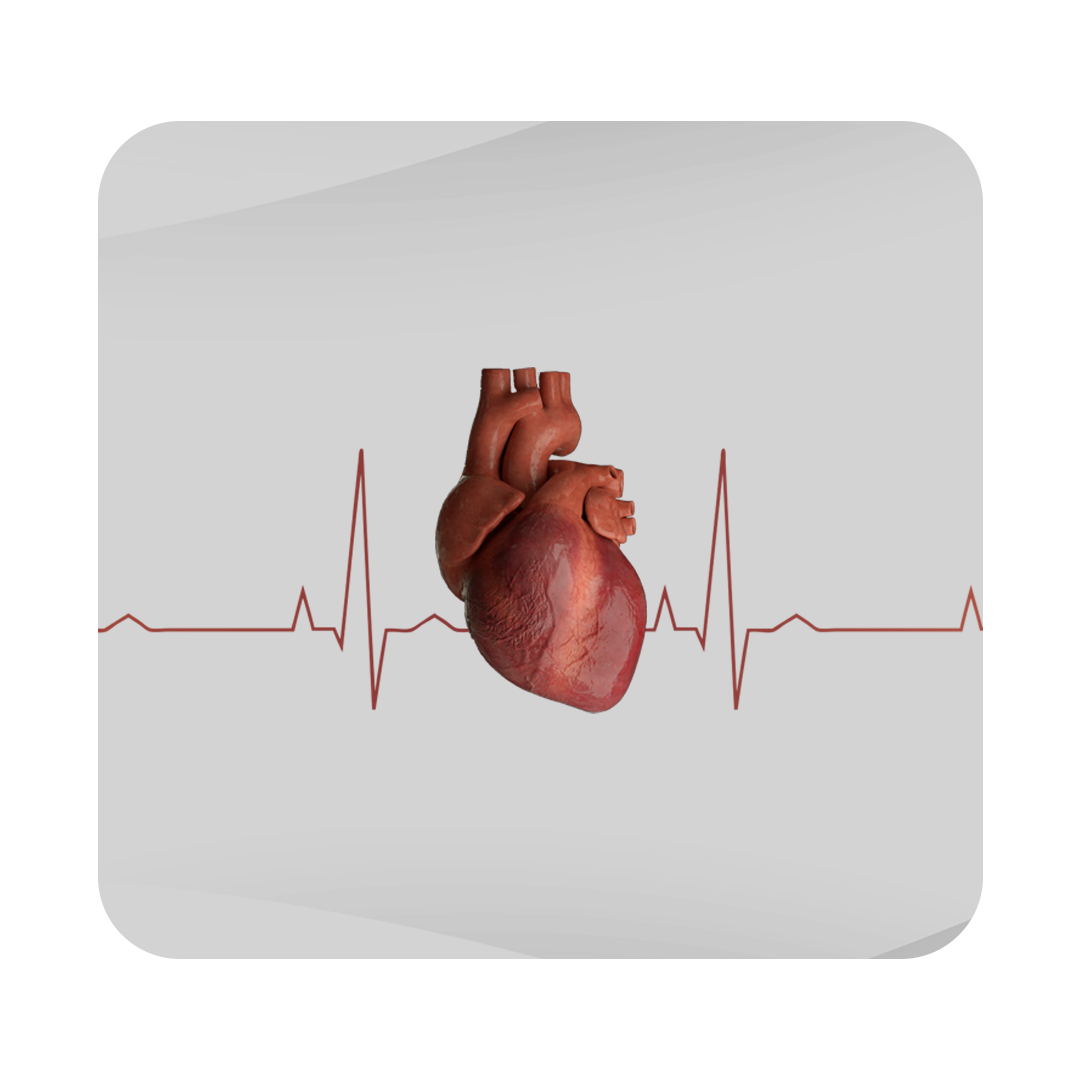
RHYTHMIC BREATHING - RHYTHMIC HEART
It is in the rhythm that we find well-being, for example music, dance or a walk. The rhythm of the heart follows the rhythm of the breathing.
Fast and shallow breathing or when we constantly hold our breath has a negative effect on the heart. The Relaxator helps you with a relaxed and rhythmic breathing that makes life a little easier for the heart.
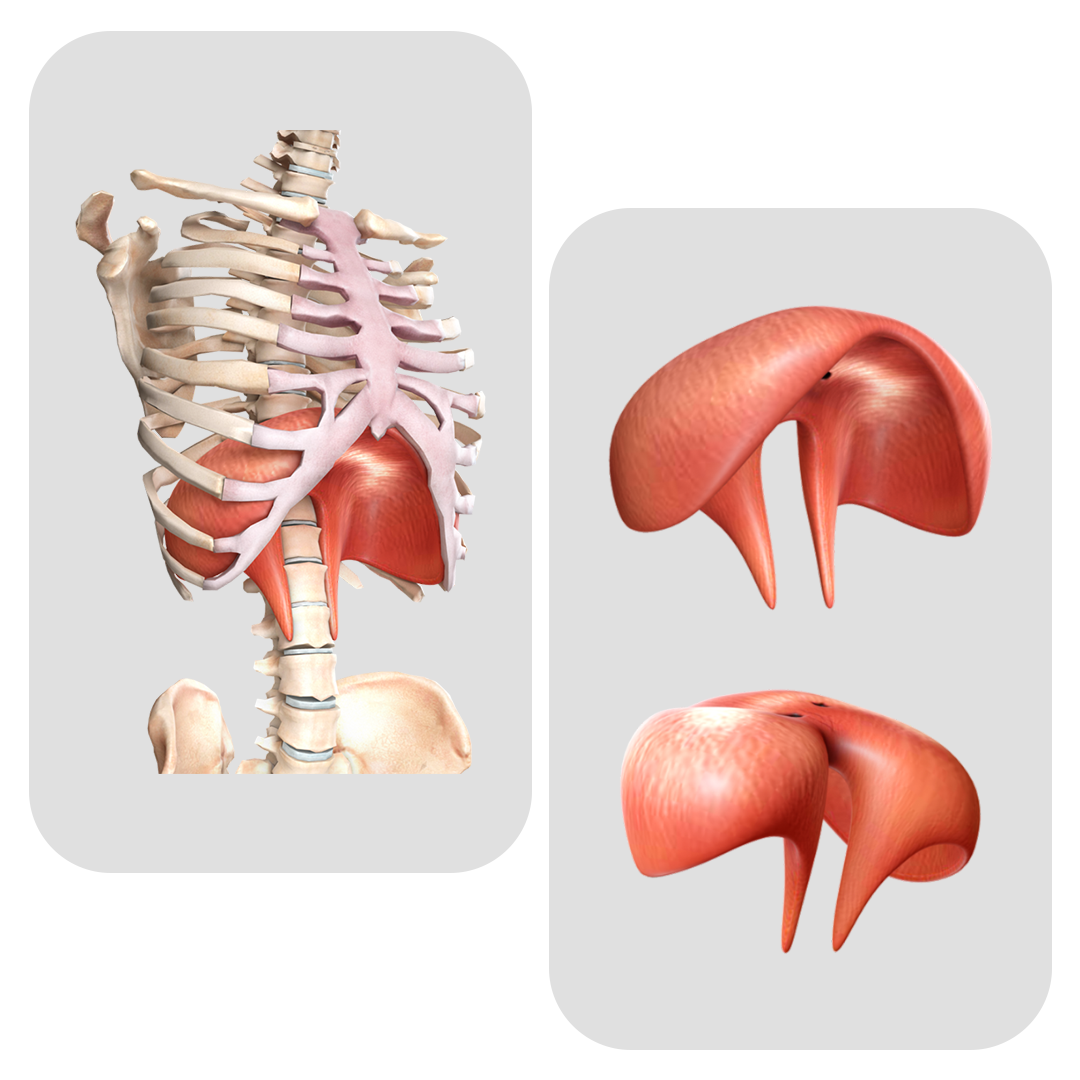
THE RELAXATOR STRENGTHENS YOUR DIAPHRAGM
ALWAYS ACTIVE. The heart and diaphragm are the only muscles that never rest. They are constantly active and keep us alive by pumping blood and moving the air in and out of our lungs.
EFFICIENT BREATHING. Using the Relaxator strengthens the diaphragm, our most important breathing muscle. A well-functioning diaphragm is a prerequisite for low, slow and efficient breathing.

LESS DESIRE FOR SWEETS AND INCREASED FAT BURNING
CRAVINGS. Fast and shallow breathing impairs oxygenation, which results in low energy and increases cravings for sweets and fast energy. The Relaxator gives efficient oxygenation and less cravings.
FAT BURNING. Stressed breathing effectively closes the door to our fat reserves, forcing our body to choose sugar as energy source. The Relaxator promotes fat burning through slow and calm breathing.
WHEN CAN YOU USE THE RELAXATOR
Anytime, anywhere - in the car, in front of the TV, at the computer, when cooking, before going to sleep, during physical activity, when reading, when you need to be focused, concentrated and creative.
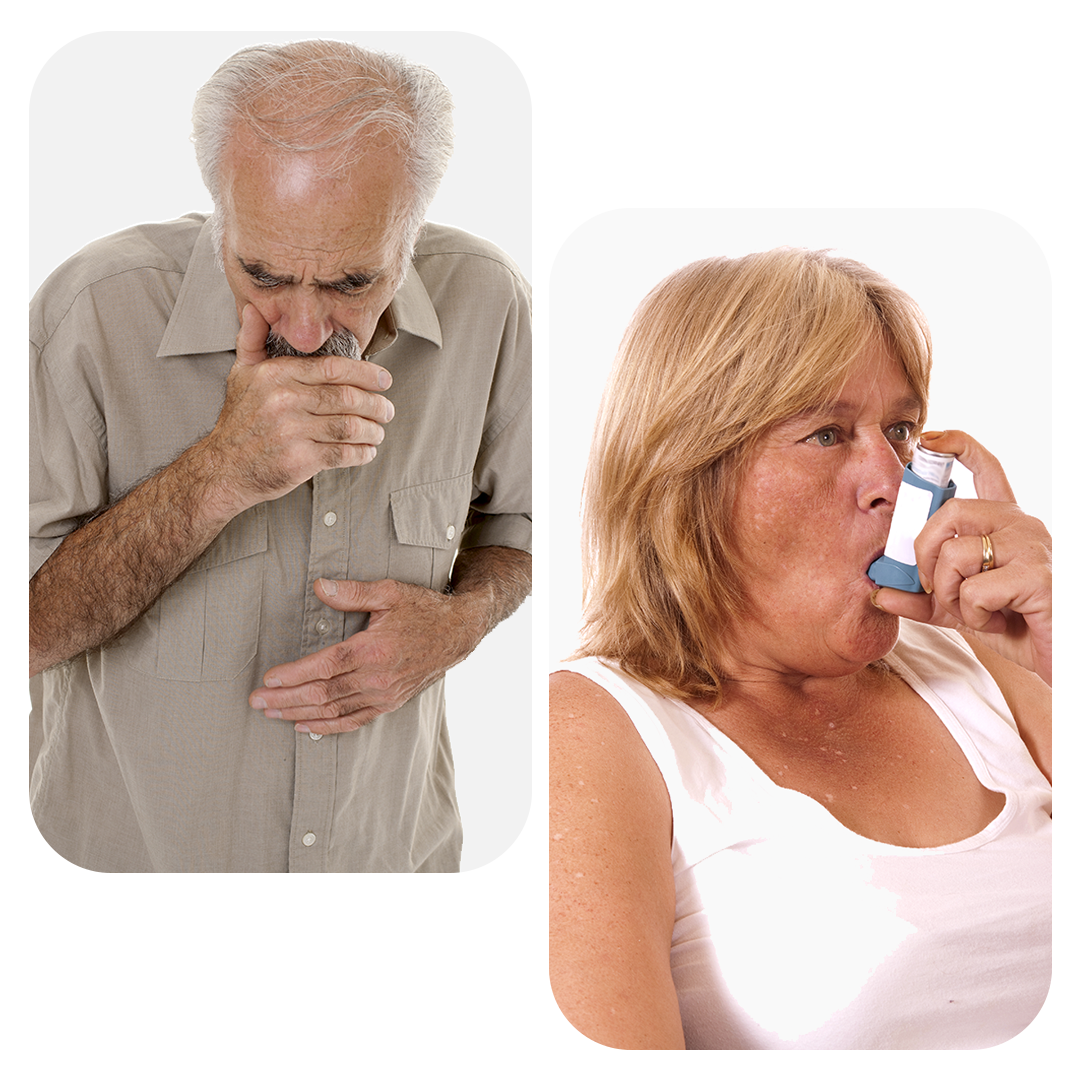
USE FOR COUGH AND RESTRICTED AIRWAYS
REDUCE COUGH. We cough to get rid of particles stuck in the airways. Exhaling through the Relaxator increases the pressure and air circulation in the lungs, reducing the need to cough, as the particles are removed naturally.
OPEN AIRWAYS. The Relaxator calms breathing, which helps to increase carbon dioxide in the airways. As carbon dioxide has a relaxing and widening effect on the smooth muscles that surround the airways, they open up.

STAY CALM UNDER STRESS, ANXIETY AND ANGER
STRESS AND ANXIETY. Our inner stress is reflected in our breath. By changing your breathing, you can reduce your stress and anxiety and dare to stay longer in difficult situations. In other words - you become braver.
ANGER. By turning to your breathing when you're angry and upset, you can help calm your nervous system and get out of fight and flight and feel calm and safe.

GET MORE ENERGY AND REDUCE PAIN
MORE ENERGY. Converting nutrition into energy with the help of oxygen is much more efficient than without, as up to 16 times more energy is extracted from the same nutrient.
LESS PAIN. When we experience pain, we are usually also tense and consequently our breathing is also tense and fast. Through low, slow, rhythmic breathing, you can increase your ability to relax and thereby reduce pain.
HOW DO I USE THE RELAXATOR?
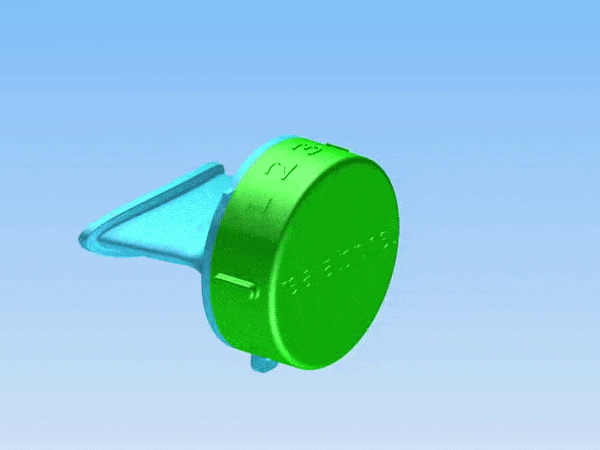
1. Set the resistance
Set the resistance of your choice by turning the Relaxator mouthpiece to adjust the vent.
There are five levels of resistance: the smaller the opening, the greater the resistance. Five is the heaviest resistance and one is the lightest.
The aim is for you to achieve a low, slow, small, relaxed and rhythmical breathing, so it is recommended that you increase the resistance slowly and gradually to make sure your breathing stays relaxed.
-
2. Bring the Relaxator to your mouth
Bring the Relaxator to your mouth. Let it rest gently between the lips for greatest relaxation. If possible, refrain from biting it with your teeth since this causes your jaw to tense up and increased amount of saliva.
-
3. Breathe out through the Relaxator
Exhale slowly and calmly through the Relaxator. At exhalation your abdomen and the lower part of your chest should slowly contract while the upper part of your chest and shoulders remain still.
-
4. Inhale calmly through your nose
Inhale calmly through your nose — just let the inhalation happen and let the air in. At inhalation the air passes into your abdominal area. Your abdomen slowly expands while the upper part of your chest and shoulders remain still. The lower part of your chest may expand a little. Please note that the main focus when using the Relaxator should be on the outbreath, since if we get the exhalation right, a good, low, diaphragmatic inhalation will follow.
-
5. Use the Relaxator fifteen minutes once or twice a day
Using the Relaxator for fifteen minutes once or twice a day gives good results. There is no limit to how long time it may be used at a time. Some people opt to use it for 1–2 hours a day. An optimal respiration of 8–12 breaths per minute, with 0.5 liters of air per breath is achieved when the resistance is set to 3–4. Please note that our breathing affects every single aspect of our lives, so if you train too hard in the beginning with the Relaxator you may experience cleansing reactions.
-
6. Maintain a relaxed breathing when training with the Relaxator
Endeavor to maintain a relaxed, non-strained breathing when you use the Relaxator. There is no need to push yourself too hard in order to achieve results. Note how you breathe after having used the Relaxator. If your breathing afterwards is relaxed and rhythmic, the Relaxator is set it to a suitable resistance.
FREQUENTLY ASKED QUESTIONS
Since the carbon dioxide levels are high when you have COPD, why should you use the Relaxator?
Question: Can you explain how blowing in the Relaxator can, in some people, increase the level of carbon dioxide and in people with, for example, COPD or pulmonary emphysema, reduce the level of it, as these people retain too much carbon dioxide?
Answer: Many of us breathe in a way that exceeds the needs of our body, which is essentially a low-grade form of hyperventilation. The big problem with hyperventilation is that we get an imbalance between oxygen and carbon dioxide: we get too much oxygen and too little carbon dioxide. More information on the disadvantages of a low carbon dioxide pressure can be found in this article: “Carbon dioxide pressure more important than blood pressure”.
When we breathe in using the Relaxator, the purpose is, among others, to calm down our breathing and breathe more slowly. Slower breathing will reduce hyperventilation. In other words, the amount of air we breathe in and out per minute or hour will decrease. By slowing breathing, we will retain more carbon dioxide in our bodies, which will lead to increased carbon dioxide pressure.
If you have COPD (chronic obstructive pulmonary disease) or pulmonary emphysema, parts of your lungs are destroyed due to the collapse of alveoli (pulmonary vesicles responsible for the exchange of oxygen and carbon dioxide in the bloodstream). It then becomes difficult to fully exhale air, and as a result, your lungs and air passages will retain some of the carbon dioxide.
If the person with COPD or pulmonary emphysema exhales through a Relaxator or some similar device which increases resistance upon exhalation, the pressure in the person’s lungs will increase. The increased pressure will cause the alveoli that have collapsed, to widen, which means that the carbon dioxide can be extracted from the blood so balance can be restored.
To sum it all up, Relaxator training will help in restoring an optimal carbon dioxide pressure both during over-breathing (where carbon dioxide pressure is too low) and COPD or pulmonary emphysema (where carbon dioxide pressure is too high).
The relaxator makes me drool
Question: I have tried using the Relaxator, but even though I try not to bite into it and just have it between my lips I get a lot of saliva in my mouth. That is why it is hard for me to use it.
Answer: The reasons for experiencing problems with saliva when using a Relaxator are often due to one of the following causes:
Tensed jaws. Your jaws may become tense when using a Relaxator, which will increase saliva production. If possible, it is optimal for you to hold the Relaxator between your lips, as this will provide increased relaxation compared to when you bite into it with your teeth.
Increased relaxation. If you are using a Relaxator, there will be increased activity in the parasympathetic part of the autonomic nervous system (the part of the nervous system that handles heartbeat, breathing, digestion, etc. without us having to think about it). In English, the parasympathetic system is called the rest and digest system. When we relax, the body may, thus, think it is time to eat and, as a result, secrete more saliva. And the fact that we put a Relaxator in our mouths can contribute even more to make the body think food will soon come.
Difficulty swallowing at the same time. The technique for swallowing while having a Relaxator in your mouth has to be learned, but you will usually figure it out after having used the Relaxator for a while.
Saliva is a way to get rid of waste products. One reason for more saliva is that your body becomes better balanced by the breathing training, and then the ability to rid yourself of waste products will increase. Normally, we have four ways to get rid of waste products: urine, feces, sweat and exhalation. When these are not enough, our bodies use saliva as a backup system.
Overuse at first. If we immediately start training with the Relaxator for several hours a day with a very small opening to create high resistance, and it is hard to exhale the air, it is conceivable that we may overuse the Relaxator and will need to both reduce the time we use it and open up the Relaxator a little more so that it is easier to exhale through it.
If the hole on the Relaxator is pointed downward. According to my experience, it is better if the breathing hole is pointing upwards in case of saliva problems.
My advice is to hang in and continue training with the Relaxator, as the problems usually are transient and the saliva will decrease after having used the Relaxator for a while. Another option is to take a break or work out with the Relaxator for a shorter time or with a lower resistance if you find the saliva to be a problem.
What is the best way to clean my Relaxator?
Question:What is the best way to clean my Relaxator?Answer: Here are some tips on how to clean the Relaxator:
- Soak the Relaxator in lukewarm water with some detergent.
- Flush the Relaxator below the water tap with some hot water.
- Put on some colloidal silver or some other cleansing agent.
- Place the Relaxator in a glass of lukewarm water with half a teaspoon of bicarbonate for 15 minutes. See the study below on pesticides, where bicarbonate was more effective than Clorox. After 15 minutes in bicarbonate, almost all the pesticide was neutralized.
- Take the Relaxator apart from time to time and clean it with a cotton swab. To disassemble the Relaxator, remove the back cover from the nozzle. Remove the membrane and the holder (“the wagon wheel”) by inserting a standard food knife through the nozzle and poke out the membrane. NOTE! Usually, it is possible to keep the Relaxator clean without taking it apart.
Boiling the Relaxator is not a good idea but it should be possible to clean the Relaxator in the dishwasher and set the maximum temperature to 131° F (55° C).
How do I use the Relaxator and how long shall I use it?
Apart from making you breathing more rhythmic, slow and relaxed, using the Relaxator also stimulates your diaphragm so that the air ends up in the midriff, or in other words – in the lower part of your lungs.
- Set the resistance of your choice
Set the resistance of your choice by turning the Relaxator mouthpiece to adjust the vent. There are five levels of resistance: the smaller the opening, the greater the resistance. Five is the heaviest resistance and one is the lightest. Please note that there is no competition in having the smallest hole open. The aim is for you to achieve a low, relaxed and rhythmical breathing, while the breathing volume is reduced, so it is recommended that you increase the resistance slowly and gradually to make sure your breathing stays relaxed. - Bring the Relaxator to your mouth
Bring the Relaxator to your mouth. Let it rest gently between the lips for greatest relaxation. If possible, refrain from biting it with your teeth as this will cause your jaw to tense up, increasing the amount of saliva produced. - Exhale through the Relaxator
Exhale slowly and calmly through the mouth/Relaxator. At exhalation, your abdomen and the lower part of your chest should slowly contract while the upper part of your chest and shoulders remain more or less still. On exhalation think «air up, midriff contract». Note! The main focus when using the Relaxator is on the exhale, as the inhale will automatically be as it is supposed to (low, midriff) when the exhalation is extended. - Inhale through your nose
Inhale calmly through your nose — just let the air in. At inhalation, the air passes into your abdominal area causing your abdomen to expand, while the upper part of your chest and shoulders remain more or less still. The lower part of your rib cage will expand a little in all directions. On inhalation think «air down, midriff expand to the sides». - Use the Relaxator for fifteen minutes 1-2 times per day
Using the Relaxator for fifteen minutes once or twice a day gives good results. There is no limit to how long time it may be used at any time. Some people opt to use it for 1–2 hours a day. An optimal respiration of 6–12 breaths per minute with 0.5 liters of air per breath is achieved when the resistance is set to 3–4. - Endeavor to maintain relaxed, non-strained breathing when you use the Relaxator
Endeavor to maintain relaxed, non-strained breathing when you use the Relaxator. There is no need to push yourself too hard in order to achieve results. Note how you breathe after having used the Relaxator. If your breathing is relaxed, rhythmic, low, slow and small, the Relaxator is set to a suitable resistance.
The above are general guidelines. It varies per individual how long you shall use the Relaxator and at what resistance level. Listen to your body, your thoughts, and your emotions and let them guide you. The key is relaxation. It is probably better to increase the time that you use the Relaxator over focusing on increasing the resistance.
When I use the Relaxator, I get dizzy.
If you get dizzy, it may indicate that you have the Relaxator set to at a resistance level that is too high. When we are all pumped up, it is common for us to increase our breathing more than is called for. We hyperventilate, which increases the outflow of carbon dioxide.
Carbon dioxide is constantly produced in the body and leaves the body upon exhalation. It is the carbon dioxide pressure that controls the breathing, and during stress or hyperventilation, the respiratory center is reset so that your body’s ability to tolerate carbon dioxide decreases, i.e. the carbon dioxide pressure drops. If you have the Relaxator set to a high number (high resistance), the carbon dioxide builds up too quickly, and you may get dizzy and feel faint. It is your body trying to make you stop doing what you are doing, i.e. it wants you to breathe in a way that causes the carbon dioxide pressure to be kept at the level your breathing center is set to.
It is not wrong to challenge ourselves as it makes us aware of where our limits are. Many of us are, however, very competitive, which may cause us to run over our bodies, which we may become aware of when breathing exercise. What the Relaxator helps you with do is increase your ability to tolerate carbon dioxide, and thus, be able to breathe more slowly. But the key is to take it at a rate you can handle. Here is an article that highlights how the carbon dioxide pressure affects our health.

